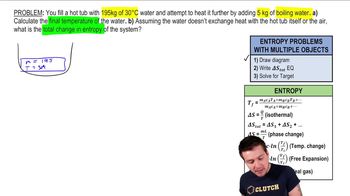23. The Second Law of Thermodynamics
Entropy Equations for Special Processes
Learn with other creators
Practice this topic
- Multiple Choice
3 moles of an ideal gas are in the left side of an hourglass-shaped container, separated by a thin barrier. The right side is completely empty, but the volume of the left and right sides are equal. The barrier is suddenly removed, and the gas freely expands into the vacuum. What is the change in entropy?
403views1comments - Textbook Question
(III) The specific heat per mole of potassium at low temperatures is given by C_V = aT + bT³, where a = 2.08 mJ/mol · K² and b = 2.57 mJ/mol· K⁴ . Determine (by integration) the entropy change of 0.15 mol of potassium when its temperature is lowered from 5.0 K to 1.0 K.
139views - Textbook Question
(III) A general theorem states that the amount of energy that becomes unavailable to do useful work in any process is equal to T_L∆S , where T_L is the lowest temperature available and ∆S is the total change in entropy during the process. Show that this is valid in the specific cases of:
(a) a falling rock that comes to rest when it hits the ground;
133views - Textbook Question
(III) A general theorem states that the amount of energy that becomes unavailable to do useful work in any process is equal to T_L∆S , where T_L is the lowest temperature available and ∆S is the total change in entropy during the process. Show that this is valid in the specific cases of:
(b) the free adiabatic expansion of an ideal gas;
160views - Textbook Question
(III) Determine the work available in a 2.2-kg block of copper at 490 K if the surroundings are at 290 K. Use results of Problem 57.
110views










